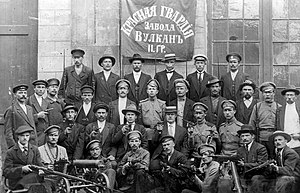 The October Revolution (Russian: Октя́брьская револю́ция, tr. Oktyabr'skaya revolyutsiya, IPA: [ɐkˈtʲabrʲskəjə rʲɪvɐˈlʲutsɨjə]), officially known in Soviet literature as the Great October Socialist Revolution(Вели́кая Октя́брьская социалисти́ческая револю́ция, Velikaya Oktyabr'skaya sotsialističeskaya revolyutsiya), and commonly referred to as Red October, the October Uprising, the Bolshevik Revolution,[2] or Bolshevik Coup was a revolution in Russia led by the Bolsheviks and Vladimir Leninthat was instrumental in the larger Russian Revolution of 1917. It took place with an armed insurrectionin Petrograd on 25 October (7 November, New Style) 1917.
The October Revolution (Russian: Октя́брьская револю́ция, tr. Oktyabr'skaya revolyutsiya, IPA: [ɐkˈtʲabrʲskəjə rʲɪvɐˈlʲutsɨjə]), officially known in Soviet literature as the Great October Socialist Revolution(Вели́кая Октя́брьская социалисти́ческая револю́ция, Velikaya Oktyabr'skaya sotsialističeskaya revolyutsiya), and commonly referred to as Red October, the October Uprising, the Bolshevik Revolution,[2] or Bolshevik Coup was a revolution in Russia led by the Bolsheviks and Vladimir Leninthat was instrumental in the larger Russian Revolution of 1917. It took place with an armed insurrectionin Petrograd on 25 October (7 November, New Style) 1917.
It followed and capitalized on the February Revolution of the same year, which overthrew the Tsarist autocracy and resulted in a provisional government after a transfer of power proclaimed by Grand Duke Michael, brother of Tsar Nicolas II, who declined to take power after the Tsar stepped down. During this time, urban workers began to organize into councils (Russian: Soviet) wherein revolutionaries criticized the provisional government and its actions. After the Congress of Soviets, now the governing body, had its second session, it elected members of the Bolsheviks and other leftist groups such as the Left Socialist Revolutionaries to important positions within the new state of affairs. This immediately initiated the establishment of the Russian Socialist Federative Soviet Republic, the world's first self-proclaimed socialist state. On 17 July 1918, the Tsar and his family were executed.
The revolution was led by the Bolsheviks, who used their influence in the Petrograd Soviet to organize the armed forces. Bolshevik Red Guards forces under the Military Revolutionary Committee began the occupation of government buildings on 7 November 1917 (New Style). The following day, the Winter Palace (the seat of the Provisional government located in Petrograd, then capital of Russia), was captured.
The long-awaited Constituent Assembly elections were held on 12 November 1917. In contrast to their majority in the Soviets, the Bolsheviks only won 175 seats in the 715-seat legislative body, coming in second behind the Socialist Revolutionary Party, which won 370 seats, although the SR Party no longer existed as a whole party by that time, as the Left SRs had gone into coalition with the Bolsheviks from October 1917 to March 1918. The Constituent Assembly was to first meet on 28 November 1917, but its convocation was delayed until 5 January 1918 by the Bolsheviks. On its first and only day in session, the Constituent Assembly came into conflict with the Soviets, and it rejected Soviet decrees on peace and land, resulting in the Constituent Assembly being dissolved the next day by order of the Congress of Soviets.[3]
As the revolution was not universally recognized, there followed the struggles of the Russian Civil War(1917–22) and the creation of the Soviet Union in 1922.
No comments:
Post a Comment